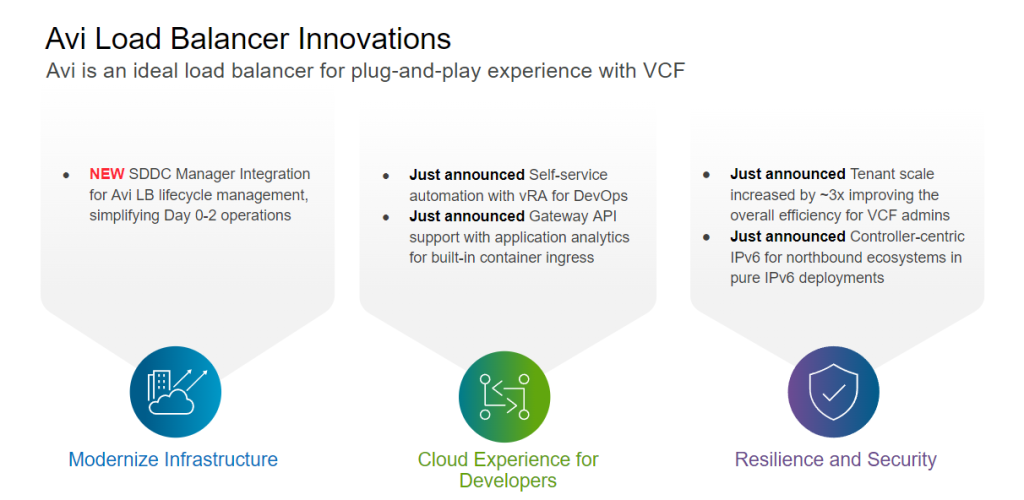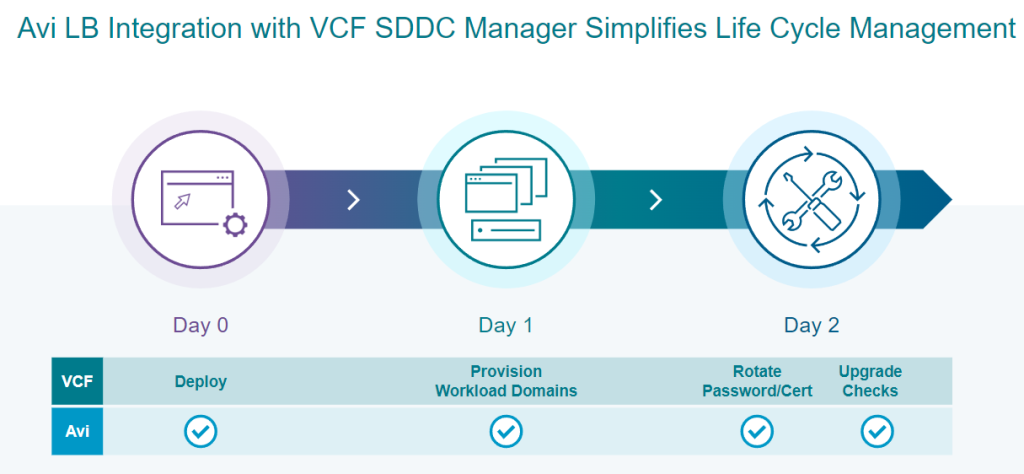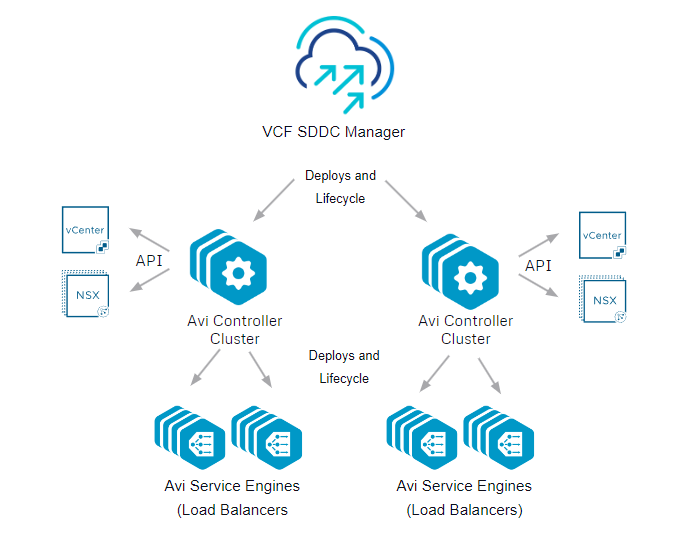Integrations with SDDC Manager for Lifecycle Management and Aria Automation for Self-Service
VMware Avi Load Balancer is dramatically accelerating customers’ application on-boarding experience due to its pioneering software-defined and distributed architecture, rich automation and built-in application analytics. Avi’s controller-driven operations can reduce the number of load balancers to manage by 10X, thus enabling significant reduction of operational complexity and enabling lower upgrade costs of hardware load balancers.
With today’s announcement, Avi is furthering the plug-and-play experience with VMware Cloud Foundation (VCF) 5.2 release through integration with VCF’s software-defined data center (SDDC) manager to streamline lifecycle management (LCM). This simplification, together with Avi’s recently announced integration with VCF’s Aria Automation (formerly, vRealize Automation or vRA) delivers self-service load balancing for DevOps and AppOps teams and enables IT to deploy load balancing at the speed of applications.

Automating Load Balancing and Accelerating Application Deployment with VCF
Every application needs a load balancer. However, a traditional hardware load balancer (LB) demands complex operations in two ways: (1) LCM of the LB appliances by the infrastructure team and (2) delivering load balancing as a service is on-boarded by the DevOps / AppOps teams who are not LB experts. Avi significantly streamlines both these aspects.
In VCF, SDDC Manager provides LCM of all key private cloud components, including compute, storage and networking. Starting VCF 5.2, Avi load balancer integrates with the SDDC Manager for the following LCM functions (see figure below):
- Day 0: deployment of Avi Controllers and Service Engines (data plane load balancers)
- Day 1: provisioning Avi with VCF workload domains as they get instantiated
- Day 2: password and certificate rotation related to the Avi controller
It further simplifies operations, automates routine tasks, and provides cloud experience for developers – essentially extending the cloud operating model for load balancing.

Avi Load Balancer Integration with VCF Workload Domains
VCF workload domains help provide a consistent and secure infrastructure for various workloads, each with a pool of dedicated resources and services tailored to specific application and line-of-business (LoB) needs. Avi integrates seamlessly with this design. Each workload domain is assigned an Avi Controller and Avi Service Engines, inheriting natively workload domain benefits: resource isolation, customizable infrastructure, lifecycle management, integrated security, scalability, automation and orchestration.
Day 0 Deployment – Avi Controller Deployment
VCF’s SDDC Manager automates the deployment of the Avi Controller cluster. It handles everything from deploying the correct images to building the cluster, to creating all necessary user accounts on VCF components. SDDC Manager initiates deployment of Avi Controller, which then communicates directly with the VCF components including vCenter and NSX-T via API calls, automating the LCM of load balancing (see figure below).
Automation is not just about reducing human errors. It’s about ensuring that best practices are always followed. It accelerates setup, enables rapid replication across multiple Workload Domains, and enhances overall operational efficiency.

Day 1 Provisioning – how Avi fits into the workload domain construct
Built on the software-defined principles and integrated with VCF, Avi helps to eliminate inefficiencies and complexities of traffic hairpinning that occur in hardware load balancers as they are deployed external to VCF. Avi’s elastic fabric auto scales and auto heals, helping to achieve the scale-out requirements without impacting isolation for each Workload Domain. With the SDDC Manager integration, more OpEx savings can be realized through central orchestration and automation (see figure below).

Day 2 Operations – troubleshooting, password rotate and cert, upgrade checks
Avi speeds up troubleshooting of applications deployed in VCF with industry-leading application visibility. Avi provides rich telemetries to the application owner, DevOps team and the VCF Cloud admin, including how the applications are performing and how to prevent potential outages with anomaly detection. The integration of Avi with the SDDC Manager also simplifies Day 2 operations such as password or certificate updates, and enables version compatibility. It takes the operational complexities out of the hands of VCF admins who may not have LB expertise, yet responsible for delivering a cloud experience for LB services. Now VCF has a simple Avi button to push. The integrated experience also provides VCF customers with a single number to call for enterprise-grade support.
What’s Next?
Avi’s plug-and-play operations for VCF delivers cloud operating experience and self-service on-prem. Additionally, our recent Avi enhancements on tenant scale, Kubernetes and mobile/5G workloads and Avi converter tool (which streamlines migration from legacy LB to Avi) are focused on delivering consistent operations and rapid deployments for all enterprise and service provider applications.
There is more to come, including GenAI driven co-pilots to intelligently assist the load balancing team get the best experience of Avi. We look forward to sharing the next set of Avi innovations at VMware Explore in Las Vegas (August 26 – 29, 2024).








